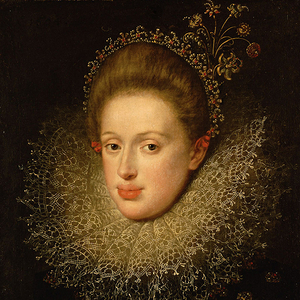
Empress Anna of Tyrol
*04.10.1585 Innsbruck - †15.12.1618 Vienna
Empress of the Holy Roman Empire
Queen of Hungary
Queen of Bohemia
Archduchess of Austria
Anna was the daughter of Archduke Ferdinand II of Tyrol and his second wife, Anna Katharina of Mantua. She married Emperor Matthias in 1611 and died childless in 1618, a few months before her husband.
Like her mother and sister, who had both decided to devote their lives to the Servite convent in Innsbruck, the Empress was also exceptionally pious. This is evidenced by the objects she used for her personal devotions, which are kept in the Spiritual Treasury in Vienna, and devotional images depicting her portrait alongside figures from the history of salvation. She had received the Golden Rose from Pope Paul V. Borghese, with which the Pope honoured a prominent figure every year on Laetare Sunday.
Through her foundation, Anna is the actual founder of the Imperial Crypt.

The sarcophagus
The chest sarcophagus displays clear physicality: its house shape is based on the ancient Egyptian belief that the coffin was the home of the dead.
The only decorations are lion's head handles, engravings on the lid with inscriptions, and a cross and coat of arms.
The feet are shaped like massive eagle claws enclosing the balls; they were added in 1755 by Balthazar Ferdinand Moll on behalf of Maria Theresa. Previously, there were simple wooden planks under the coffin.
An den beiden Seitenwänden befinden sich je drei Löwenköpfe mit Ringen als Handhaben, an der Kopf- und Fußseite die hl. Maria und Johannes. Darunter prangt in reicher Kartusche der gekrönte kaiserliche Adler mit dem viereckigen Wappenschild auf der Brust. Das Wappen ist auf die Spitze gestellt und in vier Felder geteilt, es zeigt das böhmische und ungarische Wappen und darunter den Buchstaben A. Unter dem Adler, bekrönt ein Engelskopf mit ausgebreiteten Flügeln, befindet sich die in den Sarg eingravierte Inschrift. Diese lautet:
DOMS
MONVMENTVM SERENISSIMAE AUGUSTISS. INPERATRICIC ANNAE PIAE CONIVGIS AUGUSTISS. IMPER. MATHIAE. REGINAE HUNGARIAE ET BOHEMIAE. ARCHIDUCIS AUSTRIAE. ETC. PIE DEFUCTAE VITA ET IMPERIO DIE XV MENSIS DECEMBRIS ANNO DNI MDCXVIII.
Gott, dem Besten und Größten geweiht. Sarg der durchlauchtigsten und erhabenen Kaiserin Anna, der frommen Gemahlin des erhabenen Kaisers Matthias, Königin von Ungarn und Böhmen, Erzherzogin von Österreich etc., die fromm aus dem Leben der Regierung geschieden ist am 15. Tag des Monats Dezember, im Jahre des Herrn 1618.
Im Jahre 1852 wurden die Überreste des Leichnams nach Ausbesserungsarbeiten in einen neuen hölzernen Sarg gelegt.